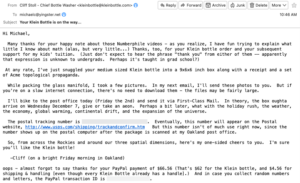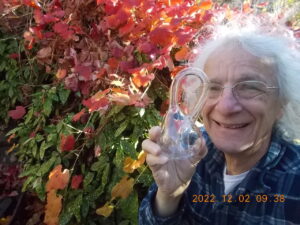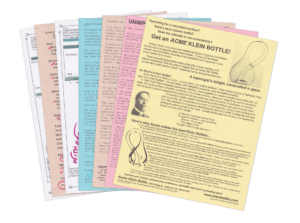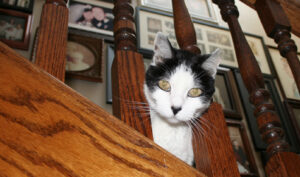Another year, another set of books!
The Things We Make: The Unknown History of Invention from Cathedrals to Soda Cans
Bill Hammack, 2023
I became aware of this book when Bill Hammack promoted it on his YouTube page. I do enjoy his videos, and thought it would be worth the read. I enjoyed it. What I felt was the main message was that engineering isn’t applied science, or complete understanding, but rather being productive with the limited understanding we currently have. The interesting addition to that is that engineers don’t have to understand why something works in order to exploit it for our benefit. Scientists will figure that out later. Engineers solve. It had good histories, anecdotes, stories, and insights to pivotal inventions ranging from thousands of year ago, the recent. I’d recommend this book. It was very interesting.
Other Minds: The Octopus, the Sea, and the Deep Origins of Consciousness
Peter Godfrey-Smith, 2016
This book was a recommendation by Adam Savage, I believe. The book touches on a lot of interesting topics, ranging from octopus behaviors, evolutionary theory, the nature of consciousness, and more. It was quite interesting. Some highlights for me include; getting insight into evolutionary tradeoffs, how we measure or recognize consciousness in animals, what animal testing can tell us about their ability to perceive. Overall, it was an enjoyable book, and while I already had an affinity for cephalopods, the book makes a good case for them being one of the most interesting animals we know of. I would definitely recommend it.
Joseph Smith: Rough Stone Rolling
Richard L. Bushman, 2005
This was an interesting read. I recently read The Saints books, and it felt like a lot of the same history was covered here. It purports to be an unbiased look at Joseph Smith’s life, which I suspect it was. It went through the different parts of his life, and history building the LDS church. It examined his youth, translating the Book of Mormon, establishing church procedures, etc. all the way up to his death. As a faithful member of the Church, I wondered what sort of history might be uncovered here that one might find shocking or unnerving. It turns out that almost nothing in it was completely new information. Most likely because of my recent reading of The Saints. It did add a lot of context to events and details that I didn’t know previously. It also gave a lot of history to Joseph Smith adjacent things like people, places, and politics. All in all, it was a fairly interesting history, and helped reinforce my understanding of the early history of the LDS church.
The Design of Everyday Things
Donal Norman, 1988
This was an interesting book. The general premise, or at least what I took away from it, was that everything is designed, and every design can be intuitive and usable without being ugly. It’s more of a philosophy book, the Philosophy of Everyday Things, but put design in the title so it wouldn’t get categorized as a philosophy book. He uses examples of everyday objects, like doors, radios, sinks, and explains conventions, how to make things intuitive, and where designers go wrong. The book was written in 98, and aside from a new preface, remains unchanged. It was interesting seeing some of his predictions, like a portable computer you carry with you all the time, or things he didn’t think would pan out well, like hyper text (HTML). Overall, I think a great read for anyone as we all interact with designed objects daily.
Contact
Carl Sagan, 1985
Wow. I really liked this book. I’ve been a fan of the film adaptation for years. While the large swaths of the story and tone are the same, the film does vary greatly from the book. The book adds a lot more detail about the decoding of the messages, and you get a sense for how long it took to decode and build the machine, which is fairly glossed over in the film. We get more characters. There is a whole additional part of the story after Ellie comes back that was super interesting. The letter from her mom at the end. It was all so good. I really enjoy the back-and-forth discussion about faith versus science. As one who has faith, but doesn’t feel that faith is at odds with science, I enjoy listening to the arguments each side has. The protagonist, Ellie, is very much a skeptic. I never felt while reading that religion or religious people are demeaned. I feel like there are a lot of themes to unpack, and I think it could benefit from a re-read down the line. I’d definitely recommend it!
Meg: A Novel of Deep Terror
Steve Alten, 1997
I naturally watched The Meg after it came out, being that I am a sucker for monster movies. I enjoyed the film, and was surprised to find out it was based on a book. The book had good reviews and so I decided to try it once I got past my backlog of queued books. The book was pretty good. It was exciting and had a decent story. The main character’s background made sense and worked to really tie the drama altogether. It felt like there was a bit of science sprinkled in here and there, not unlike a Crichton novel. It felt plausible enough and as such, I liked it. Coming off of Contact was a bit unfair perhaps, because, while it was good, it didn’t leave me with the same feeling of wonder that I had just experienced. I did feel it an entertaining novel though and would recommend it to anyone who likes sci-fi thrillers.
1776
David McCullough, 2005
1776 focused on a lot of the events and leadership during the build up to and the revolutionary war. It contained a lot of interesting anecdotes about prominent figures, like George Washington, King George III, etc. History has never been my passion, and I chose this book somewhat aspirationally as I know I ought to use my free time on more worthwhile endeavors than just various fictions. While many of the characterizations were interesting, a lot of the stories, names, and dates were not retained by my brain. I think it was a well written book, and for some would be quite educational. I recommend it for those types. I regrettably didn’t walk away feeling that I had more knowledge of these events than before, and I place that solely on me for getting easily distracted during the drier passages of the book.
All Systems Red
Martha Wells, 2017
I saw this book recommended in a Hackernews comment thread. I had never heard of it, and had no idea what it was about. I was pleasantly surprised witha short story about a security bot (who self identifies as a murder bot) who is made of a mechanical and cloned organic bits. It deals with how he views himself and his relationship with his contract owners. I thought it was a nice story and quickly paced. Since it’s so short it didn’t dwell on any one thing for too long. It was a good read and worth recommending.
Artificial Condition
Martha Wells, 2018
This is a follow-up to the previous book, All Systems Red. It continues the story of our protagonist murder-bot. He’s on a quest for answers, but also gets involved with a group of humans who are going to the same planet as him. It was a fun, albeit short story. Very entertaining. He teams up with a ship computer, ART, who helps him on his quest. I enjoyed it.
Perelandra
C. S. Lewis, 1943
I read this a long time ago on the recommendation of a friend. I thought it was time to reread it. It’s the story of the planet Venus, called Perelandra in a different tongue. A scientist, Ransom, is transported there by a divine being and meets the “queen” of Perelandra, an innocent being akin to Eve. Another scientist, Weston, comes to Perelandra via a space ship. He has been possessed by an evil spirit. Ransom and Weston have long debates with the woman and explore many philosophical and religious topics. It’s very much an exploration of what would have happened if Eve had not partaken the fruit. I think it was a very interesting book and would definitely recommend it.
Rogue Protocol
Martha Wells, 2018
This is a the next book in the All Systems Red series. Our hero SecUnit is on a mission to find evidence to use against GrayCris. Again, our hero is plunged into a situation where it has to protect a group of humans despite his desire to just be alone. He gets to the bottom of what is happening on Milu. It’s a good follow-up to the previous books, and has the same tone which so well captures our reluctant hero’s frame of mind.
A City on Mars: Can We Settle Space, Should We Settle Space, and Have We Really Thought This Through?
Kelly & Zach Weinersmith, 2023
This book was brought to my attention by the book club at work. It basically goes through all the popular ideas of how to colonize in space from orbital space station, to the moon, and to Mars and delves into the research to show how hard it would be for any of these proposals to succeed. It really resonated with me, despite loving space exploration and sci-fi, the cold hard facts that it would be a monumental effort to do such a thing speaks to the engineer inside of me who is quick to see the potential difficulties with any plan. The book is split up into parts as it were. The first talks about logistics. The middle of the book spent a lot of time on the legalities, treaties, and how politics in space work. This part was by far the least interesting to me. The parts of the book that dealt with the harder science of problems with gravity or the expense of lifting materials off of Earth were more enjoyable, but as a whole, I did like this book and it’s bit of harsh reality on all our dreams of a Moon colony. I did feel that the neglect analyzing space elevators was surprising. Overall, it was a fun book and would recommend it.
Percy Jackson & the Olympians; The Lightning Thief
Rick Riordan, 2005
I read this at the behest of my son. He has read the whole series and loved the newest TV show adaptation. I went in with a pretty blank slate. It was a fun adventure over all. I felt like it was a little heavy on the foreshadowing which seemed to telegraph plot twists a little ahead of time. It definitely has the feel of a Harry Potter type story where a boy discovers he’s more than he thought he was. I enjoyed it enough that I am planning on continuing with the series.
Marjorie
Sidney Baldwin, 1950
I read this book aloud to my daughter as it was part of her school curriculum. It was a cute story about a girl who has to leave the city and live with friends in a small coastal fishing community and learn to fit into the more rural way of life. It was a sweet story and reminded me a bit of some akin to Anne of Green Gables or Pollyanna. It was a really easy read (it’s targeted at 10 year olds). I did think that the writing style was enjoyable and easy for young readers.
The Wild Robot
Peter Brown, 2016
This was a family read we got for a long family vacation in the car. I had heard of the movie, but not heard of the book, nor seen any ads for the movie yet, so I wasn’t sure what to expect. It was a really cute story, and the kids from four years of age to eleven were all very invested in the story. The short chapters were a little odd, but it was nice for kids as it gave lots of opportunities for pausing. It was packed with a bunch of small adventures and really made us like the robot. The cliff hanger ending really made the kids demand that we continue onto the next installment.
Conclusion
This year, my list of completed books feels even shorter than the previous year. There were some longer books in there, but I also had a bit of a more chaotic year, and the books fell by the way side as a result unfortunately.
There were some great books this year. In particular, I really enjoyed these:
- The Things We Make
- A City on Mars
- The Design of Everyday Things
- Perelandra
My favorite though that I still think about and am considering rereading already was Contact. It was just a fantastic book that wove a compelling story with philosophical concepts. I just loved it so much and would pick that as my read of the year.




